Science Note: Why Lyme Disease Thrives Up North
Air Date: Week of April 14, 2017

The blacklegged tick, also known as the deer tick, is the only kind of tick that carries Lyme disease (Photo: Lennart Tange, Flickr CC BY 2.0)
Lyme Disease-carrying ticks in the northern United States have potentially more contact with humans, while southern heat creates fewer opportunities to infect people or animals. Living on Earth’s Don Lyman explains the connection between geography and tick behavior in this week’s note on emerging science.
Transcript
CURWOOD: And now, this note on emerging science from Don Lyman.
[SCIENCE NOTE THEME]
LYMAN: Lyme disease, caused by the bacterium Borrelia burgdorferi, is transmitted by ticks that bite infected animals. An infected tick can then transfer the disease to you or me, if it should happen to bite us. The typical symptoms of Lyme disease are fever, headache, fatigue, and often there’s a telltale rash. If not treated promptly, it can damage the heart, nervous system, and joints.
About 300,000 people are infected with Lyme disease every year, but it is far more common in the North than in the South. Approximately 95 percent of all reported cases occur in 14 states in the Northeast, Mid-Atlantic, and upper Midwest. Now scientists from the U.S. Geological Survey think they know why. In a recently published study, the researchers said that black-legged ticks, which transmit the disease, die of dehydration when exposed to high temperatures and low humidity.
An earlier study found that black-legged ticks in the south tend to stay hidden under a layer of fallen leaves, where, scientists hypothesize, they are able to retain moisture but are less likely to come into contact with people. And researchers found that ticks in the North often climb up plant stems, where they may more easily latch on to people who brush against them.
So, when you take a walk in the woods in the North, beware! You can be walking right through tick habitat, while in the South you’ll be walking on top of it.
That’s this week’s note on emerging science. I’m Don Lyman.
[SCIENCE NOTE THEME]
Links
The USGS Study on the geographical distribution of Lyme disease
Living on Earth wants to hear from you!
Living on Earth
62 Calef Highway, Suite 212
Lee, NH 03861
Telephone: 617-287-4121
E-mail: comments@loe.org
Newsletter [Click here]
Donate to Living on Earth!
Living on Earth is an independent media program and relies entirely on contributions from listeners and institutions supporting public service. Please donate now to preserve an independent environmental voice.
NewsletterLiving on Earth offers a weekly delivery of the show's rundown to your mailbox. Sign up for our newsletter today!
 Sailors For The Sea: Be the change you want to sea.
Sailors For The Sea: Be the change you want to sea.
 The Grantham Foundation for the Protection of the Environment: Committed to protecting and improving the health of the global environment.
The Grantham Foundation for the Protection of the Environment: Committed to protecting and improving the health of the global environment.
 Contribute to Living on Earth and receive, as our gift to you, an archival print of one of Mark Seth Lender's extraordinary wildlife photographs. Follow the link to see Mark's current collection of photographs.
Contribute to Living on Earth and receive, as our gift to you, an archival print of one of Mark Seth Lender's extraordinary wildlife photographs. Follow the link to see Mark's current collection of photographs.
 Buy a signed copy of Mark Seth Lender's book Smeagull the Seagull & support Living on Earth
Buy a signed copy of Mark Seth Lender's book Smeagull the Seagull & support Living on Earth

